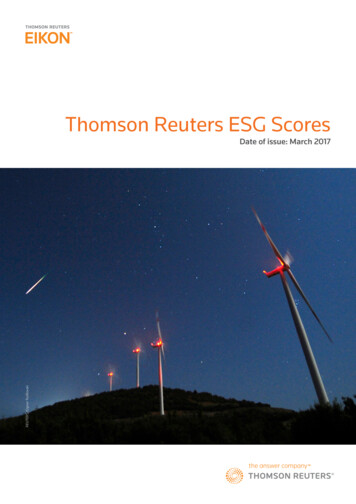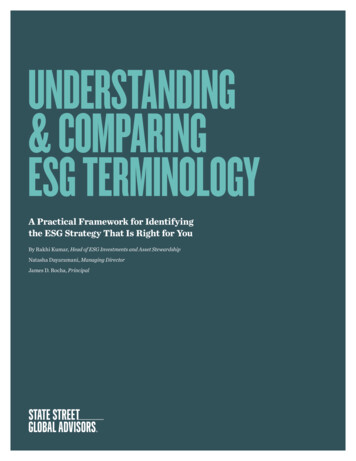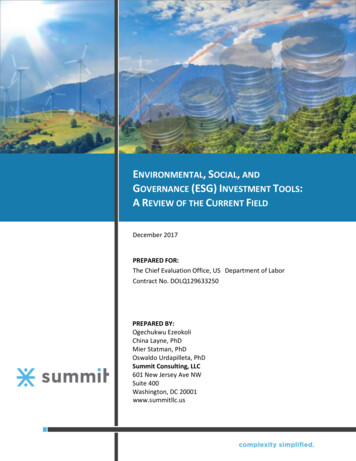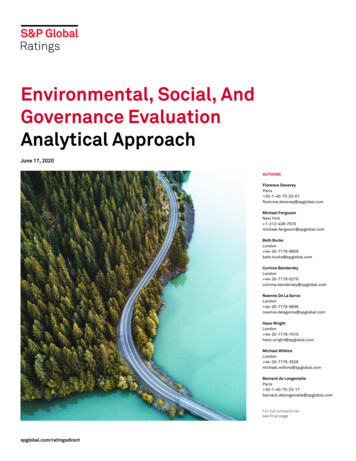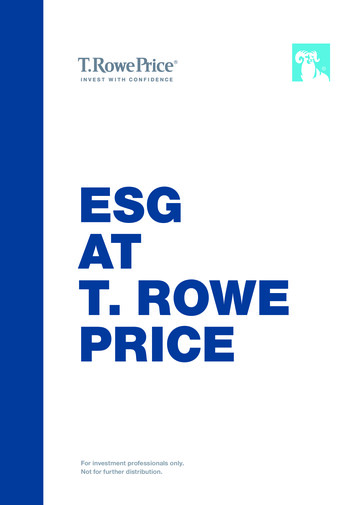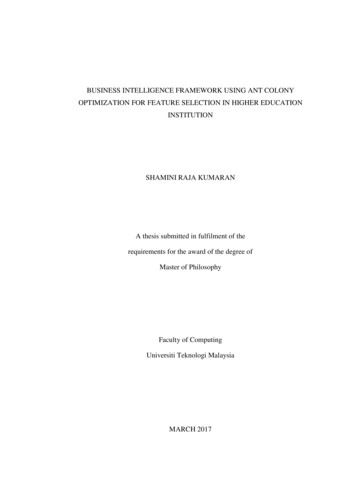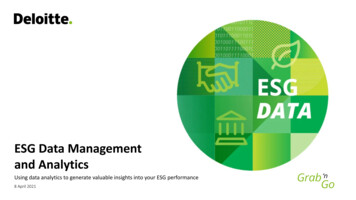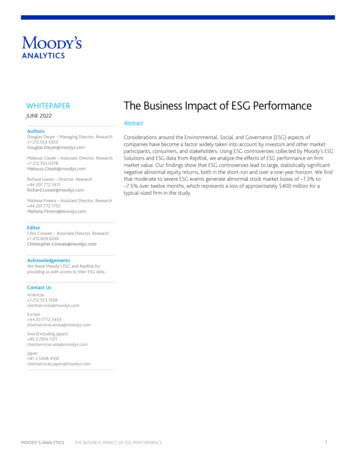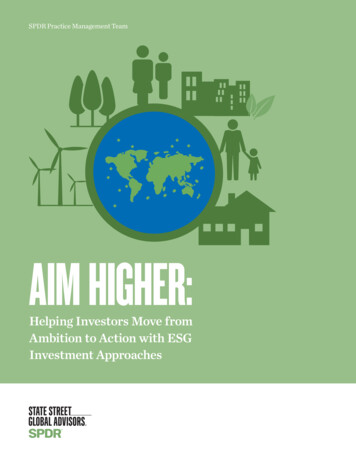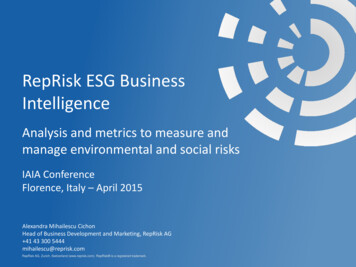
Transcription
RepRisk ESG BusinessIntelligenceAnalysis and metrics to measure andmanage environmental and social risksIAIA ConferenceFlorence, Italy – April 2015Alexandra Mihailescu CichonHead of Business Development and Marketing, RepRisk AG 41 43 300 5444mihailescu@reprisk.comRepRisk AG, Zurich, Switzerland (www.reprisk.com). RepRisk is a registered trademark.
Introduction: RepRisk is a global research andbusiness intelligence provider on ESG risks Global research and business intelligence firm specializing indynamic ESG risk analysis and metrics Founded in 1998 as environmental risk consultancy Launch of RepRisk ESG database in 2006 as a due diligence tool forthe financial sector Today, runs comprehensive database on ESG risks related tocompanies, projects, sectors and countries worldwide Database used by 100 global financial and corporate clients forrisk management, compliance, supply chain, as well as monitoringof reputation, peers, NGOs and ESG issues2
A new business imperative: ESG risks cantranslate into bottom-line impactsEnvironmental, social and governance (ESG) risksE.g. Environmental degradation, human rights abuses, corruption and fraudCompliance risks Reputational risks Financial risksE.g. Violation ofpolicies, commitments,international standardsE.g. Risks to earnings and E.g. Direct impact on cashcapital from adverseflows and capital, includingpublic perceptioncredit or investment risks,business continuity, etc.3
Two megatrends: Increased stakeholderattention and transparency amplify ESG issuesIncreased and rapidly changingstakeholder expectationsIncreased transparencyand disclosureEnvironmental, social and governance(ESG) issues have evolved fromtangential importance to materialrelevance over the last decadeThe internet and social media create ahyper-transparent and hyper-connectedworld, which serves to amplify stakeholders’expectations about ESG issues4
Big data: How can business leaders navigatethe endless stream of open-source intelligence?Source: cloudtimes.org5
Within the landscape of ESG information, anexternal perspective provides a reality checkThird-party rmationInformation sourceInformation typePolicies, management �reality”)e.g. Rating agencies,Research organizationsExternal perspective oncompany operationse.g. Annual CSRReports, Sustainabilitywebsites, Policysummariese.g. KPIs, GRI, CDP6
Why look at third-party, media andstakeholder information? Third-party, media and stakeholderinformation can provide valuableinsight into a company’sperformance – e.g. can act as anearly warning system, can providea different perspective Complements informationprovided by the company itself(“mirror”), helping to ensure adata-driven, holistic assessment Helps assess whether a company’sintention translates into reality(“reality check”)7
Leveraging stakeholder data supportstransparency and informed decision-making 80,000 sources in 15 languagesNGOsGov’tagenciesNewslettersBlogsNews sitesTwitterThinktanksPrint mediaESG RisksExtracting information that supportstranparency and decision-making Criticism Negative incidents(e.g. factory fire) Violation ofinternationalstandards Controversies .i.e. – no positiveinformation8
Broad language coverage supports the earlyidentification of risks Risks often appear earlier at the locallevel – i.e. In local sources, in locallanguages Language coverage helps ensure earlyidentification of ESG-related ianSwedish9
Following a strict, rules-based approachensures consistent data over timeESG and reputational risk1) Screen2) IdentifyProp. IT Tool4) Analyze5) QuantifyHuman intelligence- Over 80,000sources fromstakeholders,media andthird parties- ESG-related- 15 languages- Related to anamedcompany- Issues-drivensearches3) Filter- Identified as arisk (nopositive info)- SeveritythresholdAlgorithm- Removal ofduplicates- Summary ofrisk incident- Each riskincident addedonly once,unless riskprofile ofincidentchanges- Scoring of riskincidentaccording toparameters:1) Severity2) Source3) Novelty- Quality check- Risk metricthat quantifiesESG-relatedreputationalrisk exposure- From 0-100(higher moreexposure)- Available forall entitiesSystematic and rules-based, daily 5-step process10
All quantitative and qualitative data capturedon an Entity Profile PageEntities in database Coverage*Entity Profile PageRelationship analyticsCompanies 50,000**Risk metricsProjects 12,000SectorsAll sectorsCountriesAll countriesGov’t bodies 7,000NGOs 9,000Issues27 ESG issuesQualitative data: summariesand scores of risk incidentsTopic Tags36 ESG Topic Tags* Database grows daily as new information is screened, identified, filtered, analyzed and quantified** Approx. 37,000 privately-held; 13,000 publicly-traded11
What happens when no information isavailable on a specific company? In absence of company-specificinformation, the risks related to thecompany’s country and sector can beanalyzed – e.g. mining in Guatemala Country-Sector Analysis Tool plots theESG-related country risk, over whichsector risk can be plotted Country-Sector Profile Page helpsidentify “hot spots” and issues thatsupport analyses and engagement12
What new data-driven metrics are on thehorizon?RepRisk ESG Risk Rating (beta) Aims to be a simple, yet holistic ratingthat facilitates benchmarking and ESGintegration Combines the (A) reputational riskexposure of a company and (B) thecompany’s country-sector riskexposure (based upon HQ andcountries linked to risks)(B)ESG Risk Exposure(A)LowAAA, AA, AModerateBBB, BB, BHighCCC, CC, CVery highD13
“Big data” provides information that helpsmake ESG risks more manageableSource: IBM14
Appendix I:Background information
RepRisk’s scope of 27 ESG issues guides therisk screening and identification teGovernanceGlobal pollution and climatechangeHuman rights abuses,corporate complicityForced laborCorruption, bribery,extortion, money launderingLocal pollutionImpacts on communitiesChild laborExecutive compensationImpacts on ecosystems andlandscapesLocal participation issuesFreedom of association andcollective bargainingMisleading communication,e.g., “greenwashing”Overuse and wasting ofresourcesSocial discriminationDiscrimination inemploymentFraudWaste issuesHealth and safety issuesTax evasionAnimal mistreatmentPoor employment conditionsAnti-competitive practicesControversial products and servicesProduct-related health and environmental issuesViolation of international standardsViolation of national legislationSupply chainNote: All 10 Principlesof the UN GlobalCompact map toRepRisk’s ESG scope16
RepRisk’s scope also includes 36* Topic Tags –specific ESG “hot topics” and onsClustermunitionsCoal-fired c cleansingArctic drillingAsbestosConflictmineralsDeep sea drillingDepleteduraniummunitionsForest burningFrackingGamblingGMOHighconservationvalue forestsIllegal loggingIndigenouspeopleLand grabbingLandminesMonoculturesMountaintopremoval miningNegligenceNuclear powerOil sandsPalm oilPornographyPrivacyviolationsProtected areasSea-bed miningTobaccoWater scarcity* Additional Topic Tags will be added by June 2015:Hydropower (dams); Migrant labor; Predatory lending17
RepRisk selects, defines and assesses ESGissues in line with key international standardsUnited Nations Global Compact (UNGC)World Bank Group (IFC) Performance StandardsWorld Bank Group Environmental, Health and Safety GuidelinesOECD Guidelines for Multinational EnterprisesThe Equator PrinciplesILO ConventionsUnited Nations Principles for Responsible Investment (UN PRI)UN Convention Against CorruptionUniversal Declaration of Human Rights18
RepRisk runs a comprehensive and dynamicESG risk database that supports l coverage:Dynamic updates:Third-party sources:Unlimited coverage ofcompanies, listed andnon-listed, in developedand emerging marketsDatabase updated dailyas new ESG-related riskincidents are detected 80,000 third-partysources in 15 languages(not company-providedinformation)Supports effective management of ESG risks related toclients, business transactions, partners, and suppliers19
Headquarters in Zurich and over 40 riskanalysts in North America, Europe and AsiaResearch partner:SRQResearch partner:EthixHeadquarters andAnalyst HubMontrealWashington DCTampaStockholmAmsterdamBrusselsLondonZurich ViennaMilanResearch partner:JRIBishkekBeijing SeoulTokyoAnalyst HubManila20
RepRisk serves 100 global clients, helpingthem to manage and mitigate ESG risks21
RepRisk partners with key sustainability indexproviders and initiatives to advance ESG issuesMore comingin 2015 22
RepRisk ESG Risk Platform – Sector Profile Pageprovides information on sector-specific risks23
RepRisk ESG Risk Platform – Country ProfilePage to analyze country-specific risks24
RepRisk ESG Risk Platform – Topic Tag ProfilePage helps you research specific ESG themes25
Appendix II:Use cases
Putting the data to use in banking: IntegratingESG risks in KYC and due diligence proceduresInternal compliance, risk management and sustainabilitypolicies and proceduresOnboarding, periodic reviews and isk ESG Risk PlatformESG Risk PlatformFlaggedNot FlaggedIn line with policyViolation of policyEscalation to: Risk function/CRO Legal and compliance CSR/Sustainability Corporate Affairs27
Putting the data to use in insurance: IntegratingESG risk data in underwriting processesKnow your customer(KYC) and partnerUnderwritingSingle RisksAsset ManagementAll lines of business SpecialtyPropertyCasualty, incl. D&OCredit Risk and SuretyInvestment decisions28
Putting the data to use at ECAs: Data to supportenvironmental and social due diligenceOECD Common Approaches for ECAsEnvironmental and social due ject ctorRepRisk ESG Risk PlatformIn line withECA PoliciesNot in line withECA Policies29
Putting the data to use in asset management:ESG integration into all asset classesCRO OfficeProject FinancePrivate EquityInputHigh-yield bondsCorporate bondsEquity EMEquityPortfolioManagementAdherence to ESG riskmanagement policiesRepRiskESG RiskPlatformand DataFeedList of all investmentpositions for all assetclassesOutput1) Daily monitoring and alertsfor policy-related ESG riskincidents2) In-depth research triggeredby high risk incidents andpossible engagement withportfolio manager andresearch teams30
Putting the data to use in supply chain:Supporting supplier selection and monitoringStandard settingand Supplier Codeof ConductSelectionSelection ofofrelevantESGrelevant ESG issuesforfor issuesbenchmarkingbenchmarkingagainst ernal policiesSupplier selectionand risk analysisSupplier monitoringand auditsAssessmentofAssessment ofsupplierESGsupplierESGriskriskbasedonbased on companycompanyspecificdataspecific dataOngoingOngoingmonitoringmonitoringof allofsuppliersall tandards ofandinternal policiesstandardsandinternal policies31
Putting the data to use in CSR, sustainabilityand communications: Data-driven researchTracking ESG trends, developments and issuesNGO monitoring and engagementCountry- and sector-specific researchPeer benchmarking and monitoringCorporate responsibility reporting (e.g. materiality analyses)Internal management reporting32
RepRisk AGStampfenbachstrasse 428006 ZurichSwitzerlandTel: 41 43 300 54 40Fax: 41 43 300 54 46Email: contact@reprisk.com
Global research and business intelligence firm specializing in dynamic ESG risk analysis and metrics Founded in 1998 as environmental risk consultancy Launch of RepRisk ESG database in 2006 as a due diligence tool for the financial sector Today, runs comprehensive database on ESG risks related to
